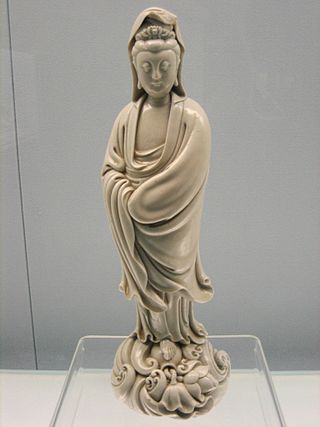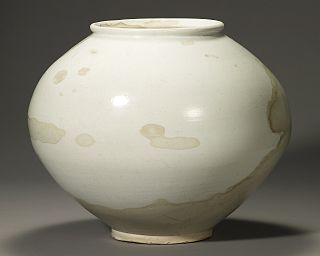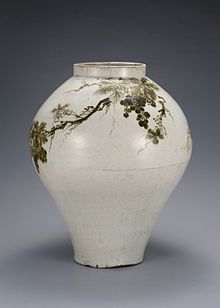
Pottery and porcelain is one of the oldest Japanese crafts and art forms,dating back to the Neolithic period. Kilns have produced earthenware,pottery,stoneware,glazed pottery,glazed stoneware,porcelain,and blue-and-white ware. Japan has an exceptionally long and successful history of ceramic production. Earthenwares were made as early as the Jōmon period,giving Japan one of the oldest ceramic traditions in the world. Japan is further distinguished by the unusual esteem that ceramics hold within its artistic tradition,owing to the enduring popularity of the tea ceremony.

Celadon is a term for pottery denoting both wares glazed in the jade green celadon color,also known as greenware or "green ware",and a type of transparent glaze,often with small cracks,that was first used on greenware,but later used on other porcelains. Celadon originated in China,though the term is purely European,and notable kilns such as the Longquan kiln in Zhejiang province are renowned for their celadon glazes. Celadon production later spread to other parts of East Asia,such as Japan and Korea,as well as Southeast Asian countries,such as Thailand. Eventually,European potteries produced some pieces,but it was never a major element there. Finer pieces are in porcelain,but both the color and the glaze can be produced in stoneware and earthenware. Most of the earlier Longquan celadon is on the border of stoneware and porcelain,meeting the Chinese but not the European definitions of porcelain.

Korean ceramic history begins with the oldest earthenware from around 8000 BC. Throughout the history,the Korean peninsula has been home to lively,innovative,and sophisticated art making. Long periods of stability have allowed for the establishment of spiritual traditions,and artisan technologies specific to the region. Korean ceramics in Neolithic period have a unique geometric patterns of sunshine,or it is decorated with twists. In Southern part of Korea,Mumun pottery were popular. Mumun togi used specific minerals to make colors of red and black. Korean pottery developed a distinct style of its own,with its own shapes,such as the moon jar or Buncheong sagi which is a new form between earthenware and porcelain,white clay inlay celadon of Goryeo,and later styles like minimalism that represents Korean Joseon philosophers' idea. Many talented Korean potters were captured and brought to Japan during the invasions of Korea,where they heavily contributed to advancing Japanese pottery. Arita ware,founded by Yi Sam-pyeong opened a new era of porcelain in Japan. Another Japanese representative porcelain,Satsuma ware was also founded by Dang-gil Shim and Pyeong-ui Park. 14th generation of Su-kwan Shim have been using the same name to his grandfather and father to honor they are originally Korean,14th Su-kwan Shim is honorable citizen of Namwon,Korea.

Korean arts include traditions in calligraphy,music,painting and pottery,often marked by the use of natural forms,surface decoration and bold colors or sounds.

"Blue and white pottery" covers a wide range of white pottery and porcelain decorated under the glaze with a blue pigment,generally cobalt oxide. The decoration is commonly applied by hand,originally by brush painting,but nowadays by stencilling or by transfer-printing,though other methods of application have also been used. The cobalt pigment is one of the very few that can withstand the highest firing temperatures that are required,in particular for porcelain,which partly accounts for its long-lasting popularity. Historically,many other colours required overglaze decoration and then a second firing at a lower temperature to fix that.

Buncheong,or punch'ong,ware is a traditional form of Korean stoneware,with a blue-green tone. Pieces are coated with white slip (ceramics),and decorative designs are added using a variety of techniques. This style originated in the 15th century and continues in a revived form today.

Chinese ceramics show a continuous development since pre-dynastic times and are one of the most significant forms of Chinese art and ceramics globally. The first pottery was made during the Palaeolithic era. Chinese ceramics range from construction materials such as bricks and tiles,to hand-built pottery vessels fired in bonfires or kilns,to the sophisticated Chinese porcelain wares made for the imperial court and for export. Porcelain was a Chinese invention and is so identified with China that it is still called "china" in everyday English usage.

Gangjingun Kiln Sites is a tentative World Heritage site listed by the South Korean government at UNESCO. It is a complex of 188 kilns which produced Goryeo ware. The kiln sites are located in Gangjin-gun,Jeollanam-do,South Korea near the sea. Mountains in the north provided the necessary raw materials such as firewood,kaolinite,and silicon dioxide for the master potters while a well established system of distribution transported pottery throughout Korea and facilitated export to China and Japan.

Hakuji (白磁) is a form of Japanese pottery and porcelain,normally white porcelain,which originated as an imitation of Chinese Dehua porcelain. Today the term is used in Japan to refer to plain white porcelain.

Dehua porcelain,more traditionally known in the West as Blanc de Chine,is a type of white Chinese porcelain,made at Dehua in the Fujian province. It has been produced from the Ming dynasty (1368–1644) to the present day. Large quantities arrived in Europe as Chinese export porcelain in the early 18th century and it was copied at Meissen and elsewhere. It was also exported to Japan in large quantities. In 2021,the kilns of Dehua were inscribed on the UNESCO World Heritage List along with many other sites near Quanzhou for their importance for medieval maritime trade and the exchange of cultures and ideas around the world.

Moon jar is a type of traditional Korean white porcelain which was made during the Joseon dynasty (1392–1910). The Joseon white porcelain was adopted as imperial ware in the fifteenth century. The name comes from its shape and milky color of the glaze to resemble the coloration of the moon.

Qingbai ware is a type of Chinese porcelain produced under the Song Dynasty and Yuan dynasty,defined by the ceramic glaze used. Qingbai ware is white with a blue-greenish tint,and is also referred to as Yingqing. It was made in Jiangxi province in south-eastern China,in several locations including Jingdezhen,and is arguably the first type of porcelain to be produced on a very large scale. However,it was not at the time a prestigious ware,and was mostly used for burial wares and exports,or a middle-rank Chinese market. The quality is very variable,reflecting these different markets;the best pieces can be very thin-walled.

Goryeo ware refers to all types of Korean pottery and porcelain produced during the Goryeo dynasty,from 918 to 1392,but most often refers to celadon (greenware).

Chinese influences on Islamic pottery cover a period starting from at least the 8th century CE to the 19th century. This influence of Chinese ceramics has to be viewed in the broader context of the considerable importance of Chinese culture on Islamic arts in general.

Yue ware or Yüeh ware is a type of Chinese ceramics,a felspathic siliceous stoneware,which is characteristically decorated with celadon glazing. Yue ware is also sometimes called (Yuezhou) green porcelain in modern literature,but the term is misleading as it is not really porcelain and its shades are not really green. It has been "one of the most successful and influential of all south Chinese ceramics types".

Cizhou ware or Tz'u-chou ware is a wide range of Chinese ceramics from between the late Tang dynasty and the early Ming dynasty,but especially associated with the Northern Song to Yuan period in the 11–14th century. It has been increasingly realized that a very large number of sites in northern China produced these wares,and their decoration is very variable,but most characteristically uses black and white,in a variety of techniques. For this reason Cizhou-type is often preferred as a general term. All are stoneware in Western terms,and "high-fired" or porcelain in Chinese terms. They were less high-status than other types such as celadons and Jun ware,and are regarded as "popular",though many are finely and carefully decorated.

Guan ware or Kuan ware is one of the Five Famous Kilns of Song dynasty China,making high-status stonewares,whose surface decoration relied heavily on crackled glaze,randomly crazed by a network of crack lines in the glaze.

China painting,or porcelain painting,is the decoration of glazed porcelain objects such as plates,bowls,vases or statues. The body of the object may be hard-paste porcelain,developed in China in the 7th or 8th century,or soft-paste porcelain,developed in 18th-century Europe. The broader term ceramic painting includes painted decoration on lead-glazed earthenware such as creamware or tin-glazed pottery such as maiolica or faience.

Jizhou ware or Chi-chou ware is Chinese pottery from Jiangxi province in southern China;the Jizhou kilns made a number of different types of wares over the five centuries of production. The best known wares are simple shapes in stoneware,with a strong emphasis on subtle effects in the dark glazes,comparable to Jian ware,but often combined with other decorative effects. In the Song dynasty they achieved a high prestige,especially among Buddhist monks and in relation to tea-drinking. The wares often use leaves or paper cutouts to create resist patterns in the glaze,by leaving parts of the body untouched.

Xing ware or Xingyao is a type of Chinese ceramics produced in Hebei province in north China,most notably during the Tang dynasty. Xing ware typically has a white body covered with a clear glaze. It was named after Xingzhou in southern Hebei where it was made;kilns sites have been identified in Neiqiu County as well as in Lincheng although Lincheng was not part of Xingzhou during the Tang dynasty. Some Xing wares were fired at a high enough temperature to be considered porcelain by Western definition,therefore Xing ware may be considered the world's first true porcelain. Xing ware was produced from the Northern Qi to the Song dynasty,and its production reached it peak during the Tang dynasty. It was supplanted by Ding ware during the Song dynasty





























